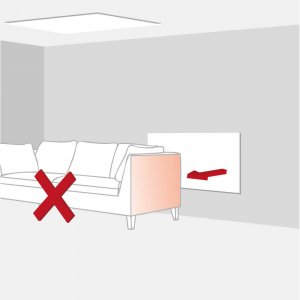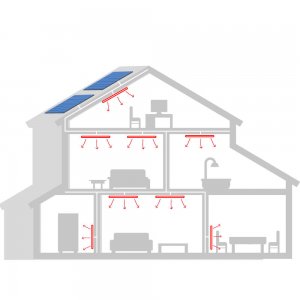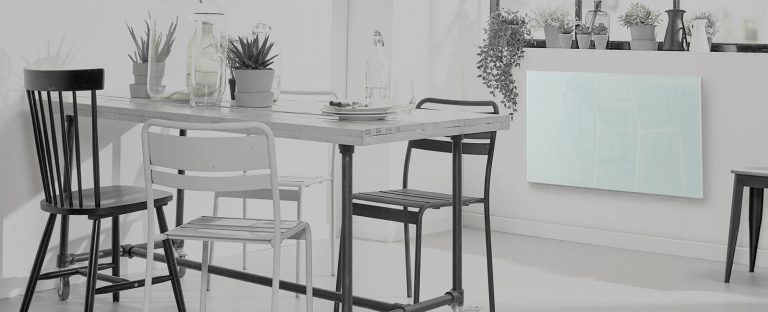Infrared heating in your home
Your own sun in the house, it sounds tempting. It is possible with infrared panels. But how would that work? Do you use them in addition to or in place of the central heating? Where would you hang it? How do you hang them? Read more below to get answers to all these questions.

Primary heating or additional heating?
With zone heating you save energy
There are two ways in which you can incorporate infrared heating into your home. You could replace all radiators with infrared panels, making infrared the primary heating system in your home. But you could also use the panels as additional heating. This is when you use the infrared panels besides your regular heating already present in your home. The infrared heater warms de objects in the direct vicinity, but also the people in the room. This allows you to set the room temperature, managed by the central heating system, to as much as three degrees Celsius lower. Thanks to the direct heat coming of the panels you still experience a comfortable warmth.
This way, you save on gas, and because the infrared panels only need to be on when you are near them, the usage of electricity can be very low. Because you only hang the panels in places where you spend a lot of time, such as the seating area or the kitchen, you could look at this way of heating as area heating. So you wouldn’t warm your entire home with infrared, just certain areas.
Replace gas heaters completely and sustainably
On the other hand, to use infrared panels as primary heating system is slightly more complicated. You would need to do a thorough calculation of how much power and panels you would need, in which places you could place the panels, and the insulation of your house. A poorly isolated house would mean a lot of loss of heat through the windows, walls and floors. The costs of keeping the temperature comfortable will be higher as a result. Nonetheless, when there is good isolation and if you generate your own renewable energy with the use of for example solar panels, infrared panels could very well be used as primary heating system. You can then replace warming on gas fully and sustainably replace with infrared panels.
Before choosing your infrared panels you need to first consider your goal of heating with infrared. Do you want to use it as area heater, besides the heaters you already have? Or do you want to completely replace your ‘old’ heating system with infrared panels? In the latter case it is important you make a proper calculation of how many panels you would need. Curious about how many panels you need to completely warm your house with infrared? Check out our neat calculator tool!
Per space
When you look at the heating issue per space, infrared heating can be especially of value in those rooms where you don’t spend time often or very long. For instance, in the bathroom you generally spend half an hour, twice a day, but in those time periods you want the temperature to be comfortable. Therefore, you probably turn on the heating, but because the air needs to warm up first it takes longer to warm up the room than you are there. An incredible waste! Infrared heating is the solution. Because the panels give off heat directly they really only need to be on when you are there. This is easily managed through a timer or an app on your smartphone. This means you save on costs and energy. Want to know more about controlling the heat panels through your phone? Read more about our Eurom Smart App!
Other rooms in which the entire space is heated – actually pointlessly – are the office, study room, hobby room or garage. In these rooms you admittedly spend more time than in the bathroom, but you often remain in one spot. By using the infrared heaters you will only heat there where you are, without needing to heat the entire room. This, too saves costs and energy, without trading in on comfort.
Wall or ceiling
Infrared heaters are usually installed on the wall or ceiling. Unlike with traditional heating, the placement of infrared panels on the wall is slightly higher. Reason for this is that with ‘regular’ heaters the placement is often blocked by sofas or tables. With convection heaters this does not matter: the warm air rises and displaces throughout the room. But infrared heaters only warm the objects within their reach. If a sofa is in front of the panel, only the sofa will be warmed up, and nothing else. It is therefore vital to place the panels as freestanding as possible.

That is why people often choose for ceiling installation. This way there are the least amount of obstacles and the heat can be spread maximally. You might think it is illogical to place the heaters on the ceiling because ‘heat rises’. With convectional heating this is true, because the warm air rises. But with infrared you do not warm the air! You warm the objects in the room such as the sofa and table because these absorb the warmth. So no heat is lost with the infrared panels as is with convection heaters, making it perfectly alright to attach them to the ceiling.
What is the best option for you?
For which type of installment you choose is mainly dependent on the purpose and object of heating. A personal consideration should be made here: the one is not necessarily better or worse than the other.


